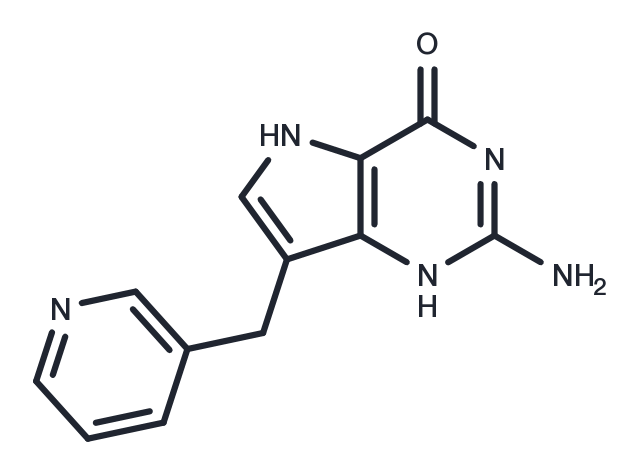Powder: -20°C for 3 years | In solvent: -80°C for 1 year


Peldesine (BCX 34) is an effective, competitive, reversible, and orally active inhibitor of purine nucleoside phosphorylase. Peldesine inhibits T-cell proliferation with an IC50 of 800 nM. Peldesine can be used in research on cutaneous T-cell lymphoma, psoriasis and HIV infection.

| Pack Size | Availability | Price/USD | Quantity |
|---|---|---|---|
| 1 mg | In stock | $ 116.00 | |
| 5 mg | In stock | $ 289.00 | |
| 10 mg | In stock | $ 463.00 | |
| 25 mg | In stock | $ 766.00 | |
| 50 mg | In stock | $ 1,070.00 | |
| 100 mg | In stock | $ 1,450.00 | |
| 500 mg | In stock | $ 2,880.00 | |
| 1 mL * 10 mM (in DMSO) | In stock | $ 318.00 |


| Description | Peldesine (BCX 34) is an effective, competitive, reversible, and orally active inhibitor of purine nucleoside phosphorylase. Peldesine inhibits T-cell proliferation with an IC50 of 800 nM. Peldesine can be used in research on cutaneous T-cell lymphoma, psoriasis and HIV infection. |
| Targets&IC50 | RBC PNP (human):36 nM , Proliferation (human T cells):800 nM , PNP (rat red blood cells):5 nM , RBC PNP (mouse):32 nM |
| In vitro | The IC50s are 36 nM, 5 nM, and 32 nM for human, rat, and mouse red blood cell purine nucleoside phosphorylase, respectively. In Jurkat cells, Peldesine (BCX 34; 0-50 µM; 72 hours) inhibits the T-cell proliferation completely at a concentration of less than 10 μM, in the presence of dGuo (10 μM). In contrast, the B-cell proliferation is not affected by Peldesine[1]. |
| In vivo | Peldesine demonstrates oral efficacy by elevating plasma inosine levels in rats (2-fold at 30 mg/kg), significantly reducing ex vivo red blood cell (RBC) purine nucleoside phosphorylase (PNP) activity in rats (98% at 3 hours, 100 mg/kg), and moderately suppressing ex vivo skin PNP activity in mice (39% at 3 hours, 100 mg/kg). Additionally, Peldesine exhibits an oral bioavailability of 76% in rats[2]. |
| Synonyms | BCX 34 |
| Molecular Weight | 241.25 |
| Formula | C12H11N5O |
| CAS No. | 133432-71-0 |
Powder: -20°C for 3 years | In solvent: -80°C for 1 year
DMSO: 195 mg/mL (808.29 mM), Sonication is recommended.
You can also refer to dose conversion for different animals. More
bottom
Please see Inhibitor Handling Instructions for more frequently ask questions. Topics include: how to prepare stock solutions, how to store products, and cautions on cell-based assays & animal experiments, etc.
Peldesine 133432-71-0 Cell Cycle/Checkpoint DNA Damage/DNA Repair Microbiology/Virology Proteases/Proteasome HIV Protease Nucleoside Antimetabolite/Analog Inhibitor inhibit PNP inosine dGuo HIV Nucleoside psoriasis phosphorylase Human immunodeficiency virus lymphoma IL-2 T-cell BCX 34 BCX-34 immunosuppressive BCX34 inhibitor
